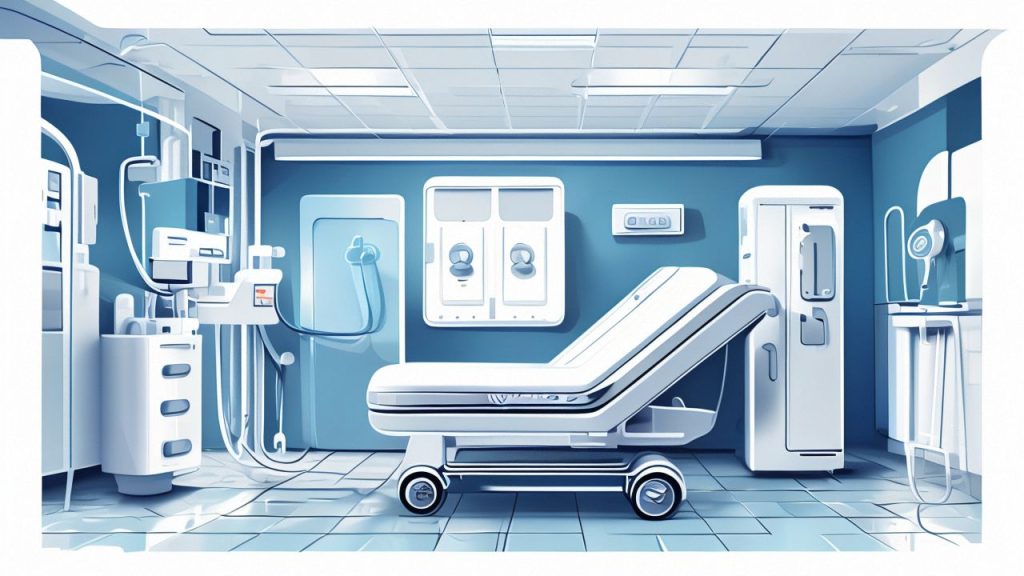A chest CT scan is a diagnostic imaging procedure that produces detailed cross-sectional images of the structures within the chest. The process involves the following steps:

- Preparation:
- The patient will be asked to remove any clothing above the waist and to avoid wearing any jewelry or metal objects that could interfere with the scan.
- They may also be asked to hold their breath at various points during the scan to minimize motion artifacts.
- Contrast Material:
- Depending on the specific reason for the CT scan, a contrast material may be used. This is a special dye that helps highlight blood vessels, tumors, or areas of inflammation.
- The contrast material can be administered through an IV in the patient’s arm.
- Positioning:
- The patient lies on a narrow table that slides into the CT scanner, which is a large, doughnut-shaped machine.
- The patient’s arms are typically placed above their head, and they are instructed to remain still.
- Scanning Process:
- The CT scanner rotates around the patient, capturing multiple X-ray images from various angles.
- The X-ray equipment is synchronized with the patient’s breathing, and the patient is often asked to hold their breath briefly to reduce image blurring.
- Image Reconstruction:
- The computer processes the X-ray data to create detailed cross-sectional images, or slices, of the chest area.
- These slices can be stacked together to form a three-dimensional image of the chest.
- Post-Scan:
- After the scan, the patient can resume normal activities and diet unless they were given a contrast material, in which case they may be monitored for a short period to ensure there are no adverse reactions.
- Results:
- A radiologist will interpret the images and provide a report to the patient’s referring physician, who will then discuss the results with the patient.
CT scans are painless and typically take only a few minutes to perform. However, the entire process, including preparation and interpretation of the images, can take up to an hour. It is a crucial tool in diagnosing a variety of conditions affecting the chest, including tumors, infections, and injuries.
A chest CT scan can provide valuable diagnostic information for a wide range of conditions and diseases affecting the chest area.
- Lung Diseases:
- Lung cancer: CT scans can detect tumors, determine their size, and assess whether they have spread to other areas.
- Pneumonia: CT scans can identify areas of infection and inflammation in the lungs.
- Tuberculosis: CT scans can help diagnose TB and determine the extent of the disease.
- Pulmonary embolism: CT scans can detect blood clots in the lungs, which can be life-threatening.
- Cardiovascular Conditions:
- Coronary artery disease: CT angiography can evaluate the blood vessels supplying the heart and look for blockages.
- Aortic aneurysms and dissections: CT scans can identify abnormal bulges in the aorta or tears in the aorta’s inner layer.
- Congenital heart diseases: CT scans can provide detailed images of the heart’s structure and any abnormalities present since birth.
- Infections and Inflammatory Conditions:
- Abscesses: CT scans can reveal collections of pus in the chest that may require drainage.
- Sarcoidosis: CT scans can help diagnose this condition by showing small granulomas in the lungs and lymph nodes.
- Sepsis: CT scans can help identify the source of infection in the chest that may be causing a systemic infection.
- Cancer:
- Besides lung cancer, CT scans can help stage other cancers that may have spread to the chest, such as breast, prostate, or colorectal cancer.
- Trauma:
- Rib fractures, pneumothorax (collapsed lung), and injuries to the chest wall can be diagnosed with a CT scan.
- CT scans can also assess the extent of injury to the heart, blood vessels, and other structures in severe trauma cases.
- Other Conditions:
- Pulmonary fibrosis: CT scans can show the characteristic patterns of scarring in the lungs.
- Pleural diseases, such as pleural effusion (fluid buildup around the lungs) or pleural thickening.
- Evaluation of the thymus gland and mediastinum (the area between the lungs) for tumors or other abnormalities.
CT scans are particularly useful when a condition is not clearly visible on a standard chest X-ray or when more detailed information is needed for diagnosis and treatment planning. They provide a more detailed look at the chest than traditional X-rays and can help guide treatment decisions, such as surgery, chemotherapy, or radiation therapy.

Well-known manufacturers
The most advanced CT scan equipment currently available on the market comes from several well-known manufacturers, including Canon Medical Systems and Philips Healthcare.
Canon Medical Systems has launched its latest CT scan devices, such as the Aquilion ONE / INSIGHT Edition and the Aquilion PRIME SP. These devices incorporate cutting-edge AI technology to enhance image quality and scanning efficiency. The Aquilion ONE / INSIGHT Edition particularly emphasizes its capabilities in cardiac scanning, offering ultra-resolution 1024 matrix imaging and a rotation speed of 0.24 seconds, enabling single-heartbeat scans at high heart rates. Additionally, these devices utilize Canon Medical’s INSTINX workflow solution, designed to simplify and standardize CT workflows, making them more efficient and user-friendly for both operators and patients.
Philips Healthcare has introduced a new AI-enhanced CT scanning system for the cardiac imaging market, the CT 5300. This system is especially suitable for cardiac coronary CT angiography (CCTA) and features new detectors optimized for AI image reconstruction algorithms. The CT 5300 enhances image quality and workflow efficiency through AI capabilities, aiming to address the challenges faced by radiology and imaging departments due to a shortage of technical staff. The system also offers virtual tools for real-time collaboration and clinical/technical support, helping to cope with increased patient caseloads, staffing shortages, and budget constraints.
Common features of these systems include the adoption of the latest technological advancements, such as AI enhancement, advanced image reconstruction techniques, and the ability to reduce radiation dosage. They also provide higher resolution and faster scan speeds. These advancements not only improve image quality but also enhance diagnostic accuracy while reducing patients’ radiation exposure. As technology continues to evolve, the role of CT scanning in the field of medical imaging becomes increasingly important.
The assistance of Chest CT scan in the diagnosis of lung cancer

The full name of CT is Computed Tomography, which works by reconstructing images obtained from X-ray scans of the human body at predetermined thickness intervals with the assistance of a computer. This allows doctors to observe each layer of body tissue from top to bottom to check for any pathological changes.
Functionally, it is similar to slicing a sweet potato into many layers and then examining each layer for any signs of rot or bad spots. There are specific standards for how thick each “cut” should be. Generally, it’s one scan per 1 cm or 0.7 cm, but in certain cases, 0.5 cm or thinner slices may be needed to avoid missing extremely small lesions, which is known as thin-slice CT scanning.
For the detection and observation of lung cancer lesions, chest CT examination is a more advanced imaging method compared to chest X-rays. Compared to chest X-rays, chest CT can detect posterior heart lesions that are difficult to visualize on anteroposterior chest X-rays.
Additionally, chest CT examination makes it less likely to miss small nodular lung cancer lesions smaller than 1 cm in diameter. Moreover, chest CT can help doctors determine the characteristics of lung lesions, such as whether the periphery of the lesion is smooth, whether there are spiculations or lobulations, whether there are cavities within the lesion, whether there is calcification, and whether there are satellite nodules around the lesion. The presence or absence of these features is very helpful in determining whether a lesion is benign or malignant, and even what type of cause or classification it may be.
Of course, there are some drawbacks to chest CT examination, such as its relatively high cost and the fact that the dose of radiation received by the examinee is higher. In recent years, some large medical institutions in China have equipped themselves with advanced multi-slice spiral CT scanners, which improve the quality of examination images without significantly increasing the radiation dose received by the examinee compared to standard chest X-ray examinations.

